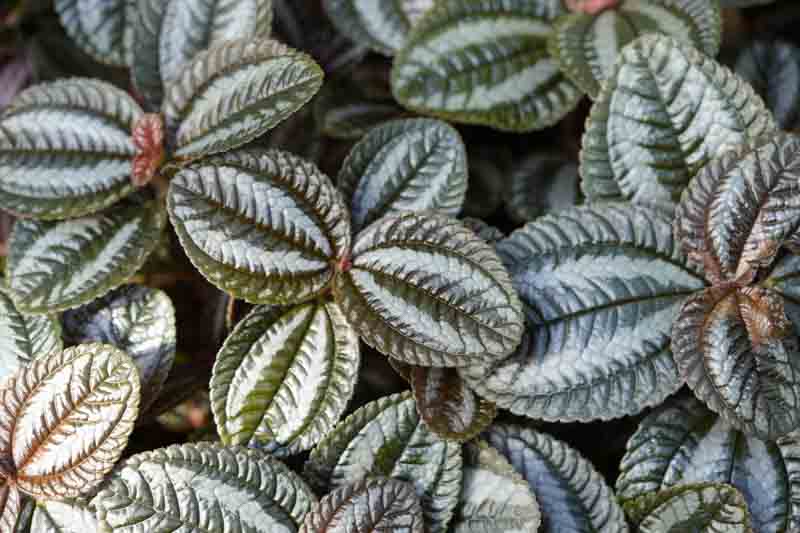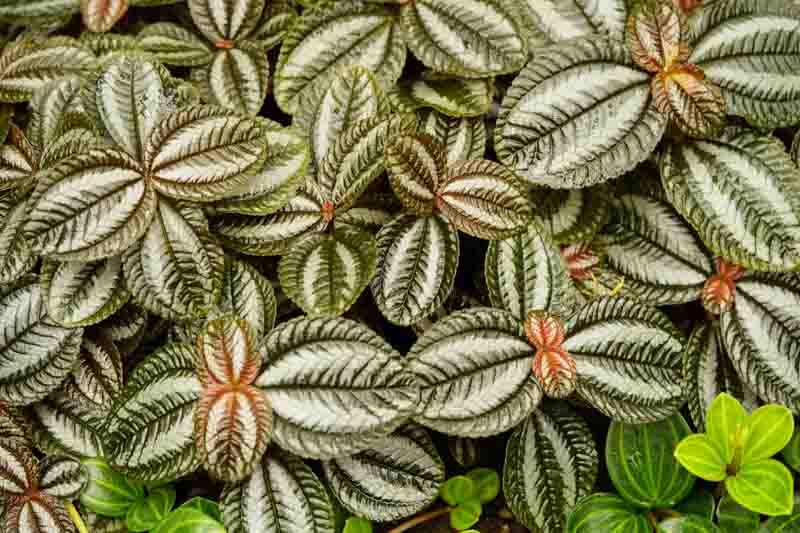Silver Tree Pilea, Silver Tree, Norfolk Friendship Plant
Pilea spruceana, commonly known as the Silver Tree or Norfolk Friendship Plant, is a captivating houseplant that adds a touch of the tropical to any indoor space. This Pilea species is appreciated for its decorative foliage and relatively easy care.
Pilea spruceana features striking leaves that blend deep green hues with metallic silver patterns, often accentuated by reddish or purplish undersides, creating a visually appealing contrast.
Native: This species is native to the tropical regions of South America, where it thrives in the moist, shaded understory of forests. It belongs to the nettle family (Urticaceae) and is part of a diverse genus with over 600 species.
Plant Type and Habit: Silver Tree Pilea is a clump-forming, evergreen perennial with a bushy, compact growth habit, ideal for indoor cultivation.
Size: It typically reaches heights and spreads of about 6-12 inches (15-30 cm), depending on the growing conditions.
Flowers: While Silver Tree Pilea does bloom, its flowers are small, greenish, and not particularly showy compared to its foliage. The plant is primarily grown for its attractive leaves.
Foliage: The foliage is the star feature, with its textured leaves marked with unique silver patterns that catch the light, adding brightness to shaded indoor areas. The leaves, oval and deeply textured with pronounced veins and scalloped edges, display a rich, dark reddish-green hue, beautifully overlaid with wide, grey-silver stripes for a striking visual contrast.
Hardiness: If grown outdoors, Silver Tree Pilea is suited for USDA hardiness zones 10-11, but due to its sensitivity to cold temperatures, it is predominantly kept as an indoor plant.
Uses: Silver Tree Pilea is primarily used as an ornamental indoor plant. Its compact size and striking foliage make it a perfect choice for desktops, shelves, terrariums, and mixed plant arrangements.
Toxicity: Pilea spruceana is considered non-toxic to pets and humans, making it a safe choice for households with animals and children.
Invasiveness: This species is not considered invasive and is well-contained in indoor growing conditions.
Benefits: Apart from its ornamental value, Silver Tree Pilea can contribute to improving indoor air quality and adding a sense of well-being to home and office spaces.

Growing and caring for the Silver Tree Pilea involves providing conditions that mimic its native tropical environment.
Light: Silver Tree Pilea prefers bright, indirect light. Avoid direct sunlight, which can scorch its leaves. A spot near an east or north-facing window is ideal, providing the plant with plenty of light without the harsh direct rays of the sun.
Soil: Use a well-draining potting mix rich in organic matter. A mix designed for houseplants, with added perlite or vermiculite for aeration, works well.
Water: Keep the soil consistently moist, but not waterlogged. Water the plant when the top inch of soil feels dry to the touch. Silver Tree Pilea is sensitive to overwatering, which can lead to root rot, so ensure good drainage by using a pot with drainage holes and a well-draining potting mix.
Humidity: This plant loves high humidity, typical of its rainforest origins. To increase humidity around the plant, you can mist it regularly, place it on a pebble tray with water, or use a humidifier. These methods help mimic the moist air of its native habitat.
Temperature: Silver Tree Pilea prefers warm temperatures, ideally between 65°F to 75°F (18°C to 24°C). Protect it from cold drafts and sudden temperature changes, which can stress the plant.
Fertilization: Feed with a balanced, water-soluble fertilizer diluted to half strength every 4-6 weeks during the growing season (spring and summer). Do not fertilize in the winter, as the plant’s growth slows down.
Pruning: Pruning is not typically necessary but can be done to maintain shape or remove any yellowed or damaged leaves. Use clean, sharp scissors to trim as needed.
Repotting: Repot the plant every 1-2 years or when it becomes root-bound. Choose a pot only slightly larger than the current one to prevent overwatering issues.
Propagating Silver Tree Pilea is straightforward and can be an enjoyable way to expand your collection or share with friends. Here’s a simple guide on how to propagate through stem cuttings:
Choose Healthy Stems: Select a healthy stem from your Pilea spruceana that has at least 2-3 leaves. Look for stems that are vigorous and free of any pests or diseases.
Cut: Using your clean, sharp scissors or pruning shears, cut a 4-6 inch section of the stem. Make sure your cutting includes at least one node (the point on the stem where leaves emerge), as this is where roots will develop.
Prepare: Remove any leaves from the bottom half of the cutting to expose the nodes. This is where you will see root growth. If using, dip the cut end of the stem into rooting hormone to encourage faster root development.
Plant: Fill a small pot with well-draining potting soil and plant the cutting into the soil, ensuring that the exposed nodes are buried. Water lightly to settle the soil around the cutting.
Create a Humid Environment: To help retain moisture and create a humid environment, you can cover the pot with a plastic bag or place it under a propagation dome. Make sure to open it occasionally to let in fresh air and prevent mold growth.
Light and Water: Position the pot in a warm spot with bright, indirect light. Avoid direct sunlight, which can be too intense for the young cutting. Keep the soil moist but not soggy. Use a spray bottle to mist the soil surface if it starts to dry out, maintaining consistent moisture levels to support root development.
Transplanting: Roots typically begin to form within a few weeks. You can gently tug on the cutting to feel for resistance, indicating root growth. Once the cutting has established a robust root system and starts showing new growth, you can begin to care for it as you would a mature Pilea spruceana.

Silver Tree Pilea is generally easy to care for, but like all plants, it can encounter pests, diseases, and common problems.
Spider Mites: These tiny pests can be identified by the fine webs they weave on the plant. They cause yellowing or speckled leaves. Increase humidity around the plant and wash it with a strong stream of water. For severe infestations, use insecticidal soap or neem oil.
Mealybugs: These white, cottony pests tend to cluster in leaf axils and under leaves, sucking sap and weakening the plant. Remove with alcohol-dipped cotton swabs or apply neem oil.
Scale insects: Hard or soft-bodied insects that attach themselves to the stems or leaves, causing yellowing and growth stunting. Scrape off with a fingernail or use a cotton swab dipped in rubbing alcohol. Insecticidal soap or neem oil may also be used.
Aphids: These small, green pests suck sap from new growth. Rinse them off with water or treat the plant with neem oil.
Root rot: Overwatering is the primary cause of root rot in Pilea spruceana. Ensure the plant is in well-draining soil, and allow the topsoil to dry out slightly between waterings.
Powdery mildew: Might affect the leaves in high humidity with poor air circulation, appearing as white powdery spots. Improve air circulation and treat with fungicide if necessary.
Leggy Growth: Insufficient light can cause the plant to stretch toward the light source, resulting in leggy, weak stems. Ensure it receives bright, indirect light for compact growth.
Leaf Drop: Sudden changes in temperature, light, or watering can cause Pilea spruceana to drop its leaves. Maintain a stable environment to avoid stress.
Fading or Scorched Leaves: Direct sunlight can bleach the leaves or cause brown, scorched spots. Conversely, too little light can make the foliage lose its vibrant color. Adjust the plant’s position to ensure it receives the right amount of light without direct exposure to harsh rays.
| Hardiness |
10 - 11 |
|---|---|
| Plant Type | Houseplants, Perennials |
| Plant Family | Urticaceae |
| Genus | Pilea |
| Exposure | Partial Sun |
| Season of Interest |
Spring (Early, Mid, Late) Summer (Early, Mid, Late) Fall Winter |
| Height |
6" - 1' (15cm - 30cm) |
| Spread |
6" - 1' (15cm - 30cm) |
| Maintenance | Low |
| Water Needs | Average |
| Soil Type | Loam, Sand |
| Soil pH | Acid, Neutral, Alkaline |
| Soil Drainage | Moist but Well-Drained |
| Characteristics | Showy, Evergreen |
| Garden Uses | Patio And Containers |
| Hardiness |
10 - 11 |
|---|---|
| Plant Type | Houseplants, Perennials |
| Plant Family | Urticaceae |
| Genus | Pilea |
| Exposure | Partial Sun |
| Season of Interest |
Spring (Early, Mid, Late) Summer (Early, Mid, Late) Fall Winter |
| Height |
6" - 1' (15cm - 30cm) |
| Spread |
6" - 1' (15cm - 30cm) |
| Maintenance | Low |
| Water Needs | Average |
| Soil Type | Loam, Sand |
| Soil pH | Acid, Neutral, Alkaline |
| Soil Drainage | Moist but Well-Drained |
| Characteristics | Showy, Evergreen |
| Garden Uses | Patio And Containers |
How many Pilea spruceana (Silver Tree) do I need for my garden?
| Plant | Quantity | |
|---|---|---|
| Pilea spruceana (Silver Tree) | N/A | Buy Plants |
Create a membership account to save your garden designs and to view them on any device.
Becoming a contributing member of Gardenia is easy and can be done in just a few minutes. If you provide us with your name, email address and the payment of a modest $25 annual membership fee, you will become a full member, enabling you to design and save up to 25 of your garden design ideas.
Join now and start creating your dream garden!
Create a membership account to save your garden designs and to view them on any device.
Becoming a contributing member of Gardenia is easy and can be done in just a few minutes. If you provide us with your name, email address and the payment of a modest $25 annual membership fee, you will become a full member, enabling you to design and save up to 25 of your garden design ideas.
Join now and start creating your dream garden!